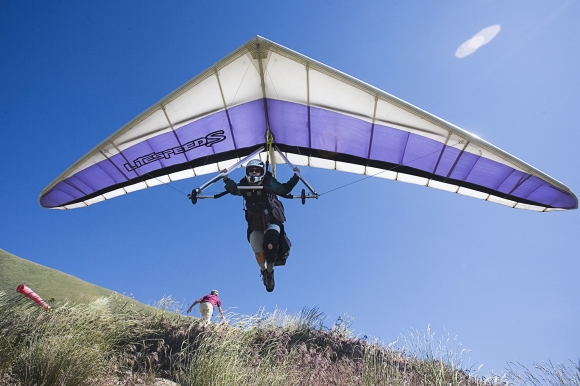
Hang gliding

Hang gliding

Hang gliding
Hang gliding is an air sport in which a pilot flies a light and unmotorized foot-launchable aircraft called a hang glider (also known as Delta plane or Deltaplane). Most modern hang gliders are made of an aluminium alloy or composite-framed fabric wing. The pilot is ensconced in a harness suspended from the airframe, and exercises control by shifting body weight in opposition to a control frame, but other devices, including modern aircraft flight control systems, may be used. In the sport's early days, pilots were restricted to gliding down small hills on low-performance hang gliders. However, modern technology gives pilots the ability to soar for hours, gain thousands of feet of altitude in thermal updrafts, perform aerobatics, and glide cross-country for hundreds of miles. The Fédération Aéronautique Internationale and national airspace governing organizations control some aspects of hang gliding. Gaining the safety benefits from being instructed is highly recommended
Training and safety
Learning to hang glide.
Since its inception, hang gliding has traditionally been considered an unsafe sport. Modern hang gliders are very sturdy when constructed by HGMA, BHPA, DHV or other certified standards and using modern materials. Although they remain lightweight craft, they can be easily damaged, either through misuse or by continued operation in unsafe wind/weather conditions. All modern gliders have built-in dive recovery mechanisms such as luff lines in kingposted gliders. Nevertheless, the inherent danger of gliding at the mercy of thermal and wind currents, has resulted in numerous fatal accidents and many serious injuries over the years, even to experienced pilots, and the resultant adverse publicity has affected the popularity of hang gliding.
As a backup, pilots may carry a parachute in the harness. In case of serious problems the parachute is deployed and carries both pilot and glider down to earth. Pilots also wear helmets and generally carry other safety items such as knives (for cutting their parachute bridle after impact or cutting their harness lines and straps in case of a tree or water landing), light ropes (for lowering from trees to haul up tools or climbing ropes), radios (for calling for help) and first-aid equipment.
The accident rate from hang glider flying has been dramatically decreased by pilot training. Early hang glider pilots learned their sport through trial and error. Training programs have been developed for today's pilot, with emphasis on flight within safe limits, as well as the discipline to cease flying when weather conditions are unfavorable, for example: excess wind or risk cloud suck.
Keine Kommentare:
Kommentar veröffentlichen